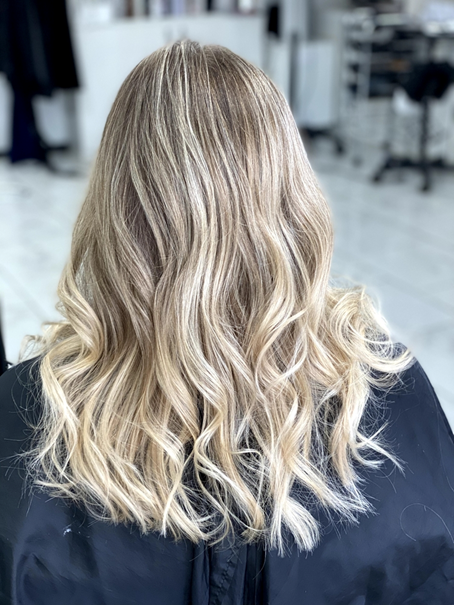Stylists constantly seek innovative techniques to elevate their craft and deliver stunning professional hair color results for their clients. One such method that has gained popularity among colorists is zone toning. This advanced approach to hair coloring allows for a more nuanced and customized finish, creating depth, dimension and seamless transitions throughout the hair.
Table of Contents
Understanding Zone Toning
Zone toning is a sophisticated coloring technique that involves applying different toner formulas to specific areas. By dividing the hair into three distinct zones, colorists can achieve a more natural-looking and multidimensional result. This method is particularly effective after lightening services, as it allows for precise control over the final shade and helps blend harsh lines or demarcations.
The Three Zones Explained
To master zone toning, you need to understand the three primary zones and their characteristics:
Zone 1: The Regrowth Area
The first zone includes the roots and area closest to the scalp, typically extending about 1/2 to 2 inches from the hairline. This zone often requires the darkest formula of the three, as it creates a root shadow that seamlessly blends with the client’s natural hair color. Adjust the exact length of this zone based on the client’s hair type, texture, and desired style.
Zone 2: The Mid-Lengths
Following the regrowth area, Zone 2 covers the mid-lengths of the hair. The toner formula applied to this section should be slightly lighter than the one used in Zone 1 to create a gradual transition between the root area and the ends. You can customize the shade and depth to achieve the desired contrast level and overall effect.
Zone 3: The Ends
The final zone consists of the ends, often the most porous and damaged due to previous color treatments and environmental factors. When applying toner to Zone 3, monitoring the processing time carefully is crucial to ensure proper toning without overprocessing. This zone typically receives the lightest formula to create brightness and dimension at the tips.
The Zone Toning Process
Preparation and Pre-Lightening
Before beginning the zone toning process, the hair must be properly prepped and, in most cases, pre-lightened to the desired level. This step is crucial for creating an even canvas on which to apply the toners. When working with a hair lightener, be sure to choose the appropriate strength of hair color developer to achieve the desired lift while minimizing damage.
Formulating for Each Zone
After lightening, it’s time to create custom toner formulas for each zone. When selecting your toners, consider the client’s desired outcome, natural hair color and current level of lift. It’s helpful to use a color wheel and your professional expertise to determine which tones will best neutralize any unwanted hues and create the perfect shade.
Application
When applying the toners, start with Zone 1 and work your way down to Zone 3. Use a brush for precise application, and be sure to saturate the hair evenly within each zone. Use gentle, sweeping motions where the sections meet to create a seamless blend between zones.
Benefits of Zone Toning

Zone toning offers numerous advantages for both stylists and clients:
Enhanced Dimension and Depth
Zone toning creates a more dynamic and multifaceted color result by using multiple toner formulas. This technique adds dimension to the hair, mimicking the natural variations in tone that occur in virgin hair.
Customized Results
Zone toning allows for a high degree of customization, enabling stylists to tailor the color to each client’s features and skin tone. This level of personalization results in more satisfied clients and a stronger stylist-client relationship.
Improved Blending and Transitions
One key benefit of zone toning is its ability to create smooth, natural-looking transitions between shades. This is particularly useful when addressing significant regrowth and blending highlights with a base color.
Product Recommendations for Zone Toning
To achieve the best results with zone toning, it’s essential to use high-quality products designed for professional use.
- Toners and Glosses: Opt for professional-grade toners and glosses that offer a wide range of shades you can mix and match to create custom formulas. Look for products that provide excellent coverage and shine while being gentle on the hair.
- Hair Color Developers: Choose a versatile hair color developer system with multiple strength options. This allows you to adjust the level of lift and deposit according to each client’s needs and desired outcome.
Post-Treatment Care
Recommend appropriate hair care products to help clients maintain their new color and keep their hair healthy. Suggest color-safe shampoos, conditioners and deep conditioning treatments to replenish moisture and protein.
Tips for Successful Zone Toning
To master the art of zone toning, keep these tips in mind:
Adjust Application Based on Desired Outcome
Be flexible and willing to adapt your technique based on the client’s desired result. Some clients prefer a dramatic contrast between zones, while others may opt for a subtler, more blended look.
Monitor Processing Times Carefully
Pay close attention to the processing time for each zone, particularly Zone 3. Overprocessing can damage your client’s hair or lead to unwanted tones. Use a timer and check the hair frequently to ensure optimal results.
Educate Your Clients
Take the time to explain the zone toning process to your clients and discuss their color goals. Doing so will help manage expectations while demonstrating expertise and attention to detail.
Conclusion

Zone toning is a valuable technique that can elevate your skills as a professional colorist and provide your clients with beautiful, customized results. By understanding the principles behind this method and honing your application skills, you can create stunning, multidimensional hair color that sets your work apart. Embrace the art of zone toning and watch as your color services reach new heights of sophistication and client satisfaction.
